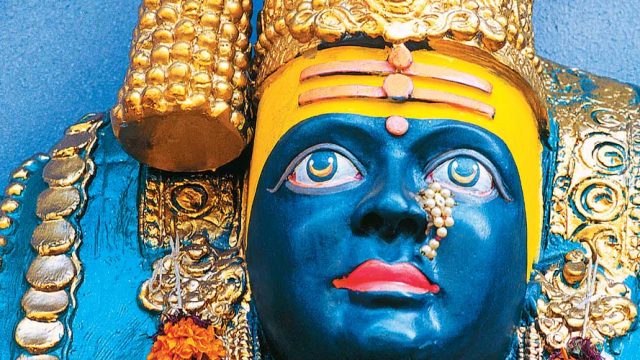“Shivaji, the Great Maratha, was here!” This is often repeated when devotees speak of the temple to Bhavani in Tuljapur. The goddess worshipped here is Kulaswamini, Maharashtra’s patron deity. It is believed that the goddess herself gifted the Bhavani Talwar, or the divine sword, to Shivaji, and he set forth upon his battles after having sought the blessings of Ma Bhavani, his ishta devata (meaning personal deity).
THINGS TO SEE AND DO
Tulja Bhavani Mandir
A ferocious demon, Mahishasura, was harassing the gods. Brahma, Vishnu and Mahesh created a pillar of fire, which transformed itself into Goddess Bhavani. In the battle that ensued, Bhavani Mata killed Mahishasura. The temple now stands where the head of the demon is believed to have fallen.
This rare chala moorti, or ‘moving idol’, is not fixed at one place. Afzal Khan, Shivaji’s enemy, once attacked the temple. The legend goes that the goddess appeared in the pujari’s dream and warned him in advance, and so the idol was shifted to a safer place, replaced with another and the original was brought back after Afzal Khan’s rampage ended.
To the left of the entrance is a stone tank, the Kallol Tirth. Bathing in it before sunrise is said to rid one of all diseases. At the Gomukh Tirth, water flows from a stone cow’s head. Equated with the Ganges, large crowds throng here. The Vishnu Tirth is on the northeastern side.
Two striking deepmalas, built by Shivaji in memory of his triumph against Afzal Khan, stand on either side of the homa kund. Inside the temple, a stone-pillared sabha mandap features images of gods and god desses. The exquisite idol is adorned with a fine array of jewellery on festive days.
Behind the temple is a round stone known as Chintamani – believed to help a devotee take the right decision. To its right is a temple to Matangi, the goddess who slayed the demon Matanga. Shrines to Khandoba, Yamaee Devi and Narsimha are also situated in the temple premises.

Other Sites
A farmer built the humble shrine to an idol he found at Dhakte Tuljapur or ‘younger Tuljapur’, 2 km away. The image resembles Tulja Bhavani.
A stone idol of Bhavani stands at Bharati Buwa’s Mutt (4 km away) where, folklore says, the goddess plays saaripat, a game of dice, with Bharati Buwa, an incarnation of Shiva.
WHERE TO STAY AND EAT
MTDC Holiday Resort (Tel: 02471-202096, Cell: 07588062947; Tariff: ₹600–900, dorms ₹900–1,300), offers nine rooms and two dorms. Hotel Son of Sun (Tel: 242161; Tariff: ₹700–1,300) has 10 rooms and a restaurant. The Shivneri Lodge (Tel: 244052; Tariff: ₹500–1,600) has a restaurant. You may also stay in Solapur where you will find better hotels.
Pawan Durga, Shivneri Lodge and Shri Lodge have restaurants offering Maharashtrian and Punjabi dishes. Other options include Samadhan and Durgai Restaurant.
THE INFORMATION
When to go Any time of the year
Tourist Office
MTDC Holiday Resort, Ghat Sheel Road, Tuljapur, Tel: 02471-202096, Cell: 07588062947, STD code 02471
Getting There
Region Marathwada
Location At an elevation of 648 m in Osmanabad District
Distance 263 km S of Aurangabad
Route from Aurangabad Via NH211
Air Nearest airport: Aurangabad (257 km/ 4 hrs). Taxi charges ₹8–10 per km
Rail Nearest railhead: Solapur (40 km/ 1 hr). Taxi costs ₹800–1,200.
Road From Mumbai, drive down the Mumbai-Pune Expressway to Pune, take NH9 to reach Solapur and then NH211 to Tuljapur.
Bus There are regular ST buses from Pune, Mumbai and Solapur. Private buses also ply on this route. For bookings, log on to redbus.in




